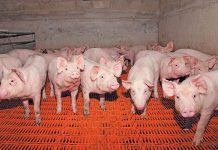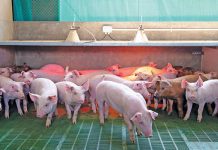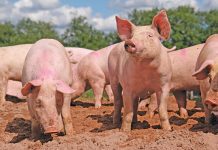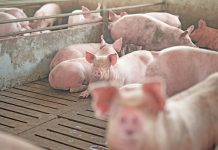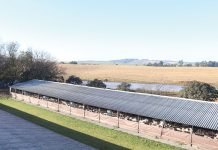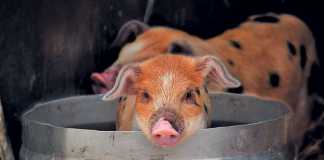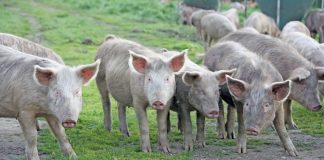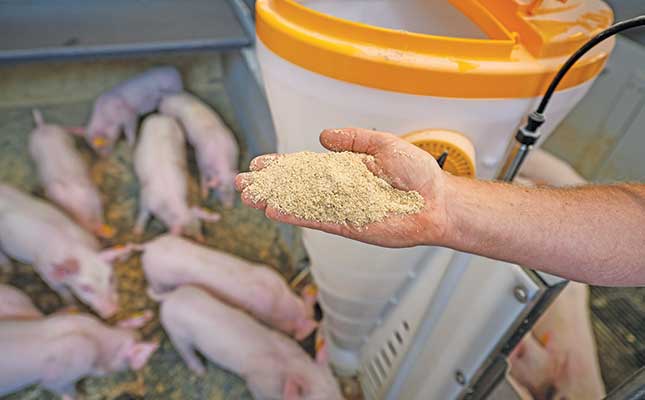
Photo: Supplied
Worldwide, rising public concern about animal welfare and the ethical rearing of livestock has placed increasing responsibility on the agriculture sector. Today’s consumers want to know more about the product they buy, particularly where it comes from (traceability) and how it was produced. These demands necessitate that farmers revise their production methods and standards, and this often places a serious constraint on profitability.
In addition to these challenges, South African pig producers have to cope with an increase in labour and energy costs as well as unstable power supply.
Direct marketing
To remain profitable, some farmers are shortening the value chain by eliminating the middleman and selling directly to consumers at farmers’ markets, over the Internet, or by vertically expanding into the value chain by opening retail shops, according to Shaun Mockford, a partner with his brother Brad in Mockford Farms, near Polokwane in Limpopo.
Mockford is also president of the Pig Breeders’ Society of South Africa and an executive council member of the South African Pork Producers’ Organisation (SAPPO).
“We have excellent pork producers in South Africa.
The challenge is to increase per capita pork consumption. It’s necessary to improve the way we present our product and improve the eating experience of the consumer.”
The Mockford family recently opened the doors of its own farm-to-fork retail shop, The Flying Pig, in Polokwane.
“We have a great product and felt that we could add value by supplying directly to the public. Our products are 100% traceable, and our farm-to-fork approach is to supply excellent-quality meat to our customers and introduce them to the versatility of pork,” says Mockford.
According to him, the direct interaction with their customers is a major benefit.
“We want to improve the public’s understanding of how food is produced. We’re able to share what’s involved when it comes to animal welfare, its cost, and how it’s achieved. We can also share recipes. To have that direct, heartfelt and thoughtful interaction on a regular basis means a great deal.
“Consumers can purchase our farm-fresh pork products at the shop, or online from the comfort of their own home. We deliver directly to their doors across Gauteng, Limpopo and Mpumalanga.
“It’s a cut-throat industry with a number of challenges that one must be aware of, and these should be managed.”
He adds that the market is volatile: customers look at the price and readily change their minds about buying the product if the price is too high.
The value of a trademark
At van Rooy, director and patent attorney at intellectual property firm Kisch IP, gives this advice: “If you’re considering selling directly to the public, it’s a good idea to register a trademark so that people can easily recognise the brand and know that the product comes from a reputable pork producer.”
He explains that a trademark can be registered with the Companies and Intellectual Property Commission to prevent competitors from using it, and is a cost-effective way to protect a business’s reputation, products and brand.
“To enable a legal firm to register a trademark, it would need details such as the name, slogan and logo, as well as all of the products or services that would be included and covered by the trademark.”
It’s important, he stresses, to check whether the intended brand name has already been registered.
Mockford admits that many farmers are not interested in vertical integration or opening a retail shop. Others use a dual system, selling produce directly to consumers and also marketing produce via other channels.
Good production practices
Regardless of their marketing methods, pig farmers have to focus on the same key elements to ensure a quality product and remain profitable:
Good management practices
Management skills can, to a large extent, determine the success of rearing piglets and realising optimal carcass weights. This includes managing production, vaccinating against diseases, and monitoring costs. Daily and weekly record-keeping is important, as this will show deviations and make it easier to address concerns before they become problems.
Proven genetics
A genetically superior pig will perform better, on average, than a genetically inferior pig, even under less favourable environmental conditions.
Quality feed
Feed efficiency is dependent on the quality of the raw materials of the feed, the diet formulation, and the nutrient absorption by the animal. Mockford advises that a farmer should invest in the best feed that is formulated according to the animals’ needs.
A comfortable, hygienic environment
The environment in which pigs are reared and kept is very important, and aspects such as temperature control, cleanliness, and access to feed and water should not be neglected.
SAPPO has set basic standards to ensure that good-quality pork is produced on farms that respect animal welfare; this means they practise proper biosecurity and environmental stewardship, and keep antimicrobial use to a minimum.
According to Mockford, raising stress-free pigs makes business sense, as it results in better growth of animals and fewer problems caused by stress and disease. Internationally, production costs remain a main driver of improved welfare on pig farms.
“Stressed pigs will be less resilient and more disease-prone than stress-free animals. They’ll also take longer to finish and be less productive,” he says.
In 2017, Mockford Farms established a partnership with DanBred Africa (DanBred).
“The partnership is built on mutual respect for our customers and for the industry. We understand the needs of the modern pig producer. Our business strategy is very clear: to offer the most profitable solutions to producers and to increase pork consumption by improving pork quality,” explains Mockford.
Mockford Farms regularly imports frozen semen through DanBred and this forms the basis of its genetic dissemination programme. According to Mockford, they import frozen semen from all three lines produced by the company, namely Landrace, Large White and Duroc.
“Regular semen imports from the highest-index boars in Denmark drives our breeding programme. To boost our genetic progress and breeding programme, we’ve increased the replacement rate of sows to 120% per year.”
Top breeds
The Large White, Landrace and Duroc lines are purebred. The Large White (originally from Yorkshire, England) and the Landrace are then crossed to produce the F1 hybrid female.
According to Mockford, the F1 is the most prolific sow in the world today. Commercial producers use Duroc terminal boars on F1 sows to produce fast-growing slaughter pigs.
The Duroc line bred by DanBred is one of the most efficient, refined terminal sires in the world, says Mockford. It is extremely fast-growing, very robust and has an exceptional feed conversion ratio.
The breed is also known for its superior meat, which is marbled and tender, shows reduced drip loss, and has a pH of between 5,4 and 5,75 and a high lean-meat percentage. It is also a desirable reddish-pink.
Mockford explains that the Duroc improves uniformity, together with reduced pre- and post-wean mortalities.
“Breeding pigs is all about balance. In our breeding programme, we want pigs with a good feed conversion rate that produce as much meat as possible, without excessive fat. The Duroc’s high marbling makes the meat tastier and juicier,” he explains.
The sows at Mockford Farms are kept in farrowing crates for a period, mainly as a safety measure to protect the piglets from being crushed.
“We don’t cut corners. We ensure that our animals are treated well, and avoid overcrowding in the pens.
“Our sows retain a productivity of 30 piglets per sow per year. We slaughter the animals at about 150 days, or 21,5 weeks, when the carcasses are at 85kg. We achieve a growth rate of about 100g/pig/day.
“As stewards of our animals, we always prioritise their health and well-being and are committed to raising them responsibly throughout each production phase.”
A high standard of biosecurity and hygiene protocols is adhered to at all times. “We implement measures that reduce the risk of the introduction and spread of diseases on-farm, and have to be diligent in adhering to these measures,” says Mockford.
To minimise the spread of diseases, all breeding herds are monitored regularly for infections.
“African swine fever is a highly contagious disease of domestic and wild pigs, and if not contained, can result in serious economic and production losses. We have to maintain the required biosecurity protocols to keep our herds safe.”
Advice for new farmers
Although pig production can provide a small-scale subsistence farmer with an opportunity to increase household income and does not require much land, certain minimum practices are required to ensure success, says Mockford.
His advice is to always buy animals from a reputable breeder and not compromise on genetics or feed quality, even during tough times.
“It’s also important nowadays to know what’s happening beyond your own farm gate. If possible, integrate into the value chain and market your own products beyond the farm gate. Pig farming is an ever-evolving industry and it’s essential to investigate the market, and keep up with global trends, new technology and research. Know your end user, and try to establish a relationship with your buyers.”
Email Shaun Mockford at [email protected].


